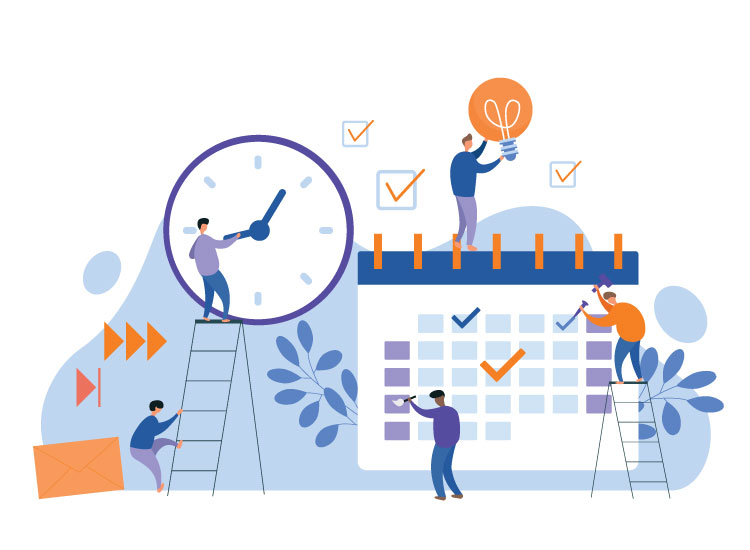Office employees spend over half of their workdays managing administrative tasks and coordinating. This “busy work” manifests in tasks like:
- Hunting down information and documents
- Chasing down project status updates
- Communicating with others about the status of tasks & projects
- Transitioning between multiple software platforms
This means professionals spend an equivalent of six full working weeks each year on tasks of little to no value instead of skilled work.
In a work-from-anywhere world, these administrative tasks can become even more challenging for teams that don’t have the right technology or processes in place to efficiently maximize working time. Luckily, much of this problem can be managed by implementing a single tool that helps to track tasks and deliverables in real-time.
Here are some examples of how your organization can save time, money, and resources by optimizing task management for professionals.
7 Ways Task Management Software for Professionals Can Lessen Administrative Burdens
1. More Efficient Prioritization
A quarter of employees plan their day by managing tasks as they arise instead of planning ahead – a system that has proved to be the least effective technique for productive time management.
Implementing a real-time task-tracking tool such as a workforce management system makes it easy for employees to prioritize which of their tasks are most pressing due to their nature or deadline, making it more likely that they’ll be spending their time where it is most needed.
2. Simplified Billing and Compliance
For employees in the professional services industry, work is often billed hourly, which means all of the time employees spend on client work must be tracked and organized by project. Workforce management systems enable task tracking and give employees the responsibility to record their time, making it easier for organizations to stay compliant with wage and hour regulations.
When it comes time to bill, managers can enter data daily and easily collect the data they need for invoices by pulling time logs from the system that separate billable and nonbillable hours. They can quickly see how much time was spent on each task for each project and invoice accordingly.
This significantly reduces the time they spend away from the skilled work for which they were hired, makes it easier to provide future estimates, enhances accuracy, and reduces the billing cycle time.
3. Time-Saving Automation
Automation is the superhero of task management for professionals, as it reduces the amount of administrative work that must be done manually. Task-tracking software can automate key aspects of project management that typically require coordination, such as:
- Notifying supervisors when a deliverable is ready for review
- Notifying team members when a task related to their project has been completed
- Tracking progress to ensure projects are on track to their deadlines
- Reminding employees of upcoming deadlines for which they are responsible
4. System Consolidation
The average employee needs to navigate through at least four different applications to complete a single business process. With this in mind, it’s no wonder employees spend 25% of their working time looking for the information they need to do their job.
The versatility of workforce management software makes it easy to consolidate information into one place, including:
- Project statuses
- Meeting notes
- Communication tools
- Timecards/payroll
- Goal setting and tracking
- Business analytics
5. Streamlined Communication
Efficient communication is key to success for task management in the workplace, especially for remote and hybrid teams of professionals.
With task management software, supervisors can provide real-time feedback and answer questions directly within the task itself so that all directions are in one place. This helps to eliminate back-and-forth communication and meetings over deliverables, project status, expectations, and ownership.
6. Aligning Work with Job Descriptions
The average employee spends more than 90 minutes each day tending to tasks and meetings that aren’t relevant to the job they were hired for. With task management software, tasks are aligned with each individual’s job description, making it easier to keep employees on task and within their lanes.
This can also improve employee satisfaction, which directly impacts retention rates.
7. To-do List Flexibility
Even when an employee sits down with a plan in place for their day, it’s likely that other tasks and priorities will surface. Real-time task tracking helps give employees the tools they need to discern which tasks are most pressing and which can wait another day while also checking off boxes as they go.
Maximize Your Employees’ Skills with Real-Time Task Tracking
Task management software for professionals pays for itself via improved productivity levels, maintained project timelines, and better resource allocation.
coAmplifi’s workforce management software provides real-time task tracking alongside tools for communication, business planning, collaboration, and more.
Schedule a demo now to see coAmplifi in action!
Source: “Make Time for the Work That Matters” by Harvard Business Review. The article was published in September 2013 and it discusses how knowledge workers can become more productive by eliminating or delegating unimportant tasks and replacing them with value-added ones. The article cites a study by the McKinsey Global Institute that found that knowledge workers spend an average of 41% of their time on discretionary activities that offer little personal satisfaction and could be handled competently by others. This means that professionals spend an equivalent of six full working weeks each year on tasks that are not essential to their job or that do not contribute to their overall productivity.


